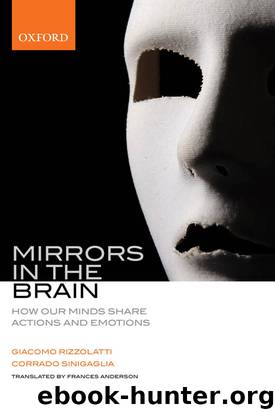Mirrors in the Brain: How our minds share actions and emotions by Giacomo Rizzolatti & Corrado Sinigaglia

Author:Giacomo Rizzolatti & Corrado Sinigaglia [Rizzolatti, Giacomo]
Language: eng
Format: azw3
Publisher: Oxford University Press
Published: 2007-11-22T05:00:00+00:00
Fig. 5.2 Cortical areas activated during observation of mimed actions (1) and object directed (transitive) actions (2) performed with the mouth (A), hand (B) and foot (C). (Buccino et al., 2001.)
Capturing the intentions of others
with our mirror systems
We have seen that both electrophysiology and brain imaging studies show that a mirror system analogous to that found in monkeys is also present in humans. There are however some significant differences: the mirror system appears to include more cortical space in humans than in monkeys although this conclusion must be treated with a certain degree of caution given the different experimental techniques used in the different species: it is one thing to record the activity of single neurons, quite another to analyse the activation of the various cortical areas on the basis of variations in blood flow. What is most important, however, is that the human mirror neuron system has certain properties which have not been found in monkeys: for example, it codes both transitive and intransitive motor acts, it is able to code both the goal of the motor act and the movements of which the act is composed, and finally, in the case of transitive actions, effective object interaction is not a mandatory condition as it can activate when the action is merely mimed.
We have already mentioned that these properties can have important functional implications; however, the fact that the human mirror neuron system can accomplish a wider range of tasks than that observed in the monkey must not obscure its primary role, i.e. the role linked to understanding the meaning of the actions of others. In fact, the TMS experiments have shown that the sight of hand acts performed by others results in an increase in the MEPs recorded in the same hand muscles used by the observer to execute the same acts. On the other hand, brain imaging studies have shown that the activation of the frontal lobe resulting from the observation of acts performed with the hands, mouth, and feet determines activations that basically correspond to the somatotopic motor representation of these body parts.
In humans, as in monkeys, the sight of acts performed by others produces an immediate activation of the motor areas deputed to the organization and execution of those acts, and through this activation it is possible to decipher the meaning of the ‘motor events’ observed, i.e. to understand them in terms of goal-centred movements. This understanding is completely devoid of any reflexive, conceptual, and/or linguistic mediation as it is based exclusively on the vocabulary of acts and the motor knowledge on which our capacity to act depends. Finally, again as in the monkey, this understanding is not limited to single motor acts but extends to entire chains of acts.
This last point emerges very clearly from an fMRI experiment conducted by Marco Iacoboni and colleagues13, in which three different videos were shown to a number of volunteers (Figure 5.3). In the first video the participants saw a number of objects (a teapot, a mug, a glass, a plate, etc.
Download
This site does not store any files on its server. We only index and link to content provided by other sites. Please contact the content providers to delete copyright contents if any and email us, we'll remove relevant links or contents immediately.
| Administration & Medicine Economics | Allied Health Professions |
| Basic Sciences | Dentistry |
| History | Medical Informatics |
| Medicine | Nursing |
| Pharmacology | Psychology |
| Research | Veterinary Medicine |
The Art of Thinking Clearly by Rolf Dobelli(9909)
The 5 Love Languages: The Secret to Love That Lasts by Gary Chapman(9273)
Mindhunter: Inside the FBI's Elite Serial Crime Unit by John E. Douglas & Mark Olshaker(8699)
Becoming Supernatural by Dr. Joe Dispenza(7831)
The Road Less Traveled by M. Scott Peck(7275)
Nudge - Improving Decisions about Health, Wealth, and Happiness by Thaler Sunstein(7239)
Mastermind: How to Think Like Sherlock Holmes by Maria Konnikova(6936)
Enlightenment Now: The Case for Reason, Science, Humanism, and Progress by Steven Pinker(6869)
Win Bigly by Scott Adams(6825)
The Way of Zen by Alan W. Watts(6288)
Factfulness: Ten Reasons We're Wrong About the World – and Why Things Are Better Than You Think by Hans Rosling(4486)
The State of Affairs by Esther Perel(4483)
Gerald's Game by Stephen King(4371)
Man's Search for Meaning by Viktor Frankl(4266)
The Confidence Code by Katty Kay(4034)
Thinking in Bets by Annie Duke(3995)
The Worm at the Core by Sheldon Solomon(3325)
Hidden Persuasion: 33 psychological influence techniques in advertising by Marc Andrews & Matthijs van Leeuwen & Rick van Baaren(3290)
Enlightenment Now by Steven Pinker(3271)
